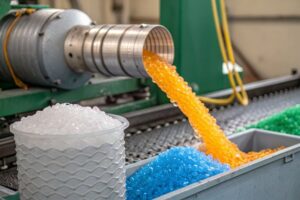In the dynamic landscape for sustainable materials, rPET straps (recycled Polyethylene Terephthalate) have emerged as game-changers. To unlock their full potential, epoxy chain extenders are crucial. This blog explores the benefits, applications, and future of rPET straps enhanced with epoxy chain extenders.
1. Introduction
1.1 Rise of rPET Straps
The demand for eco-friendly packaging and fastening solutions has exploded in recent years. rPET straps, made from recycled PET materials such as plastic bottles, have been gaining popularity. These straps are widely used in many industries, from packaging to logistics.
1.2 Limitations of rPET and the Role of Epoxy Chain Extenders
Despite its advantages, rPET straps face challenges in terms of mechanical properties and processing. Epoxy chain extenders offer a solution by enhancing rPET’s performance, enabling it to meet the strict requirements of modern applications. This not only improves rPET’s use but also contributes to a circular economy.
2. Understanding rPET Straps
2.1 Definition and Production
rPET comes from PET waste generated by post-consumer and post-industrial sources. The recycling process includes collecting, sorting, and processing waste materials to create a form suitable for strap manufacturing. Injection molding and extrusion are the two common production methods used to shape rPET into the familiar strap form.
2.2 Benefits of rPET Straps
Environmental friendliness is one of the biggest benefits of rPET straps. Recycling PET waste reduces the amount of plastic that ends up in landfills or oceans. rPET straps are also more cost-effective than traditional fastening methods, making them an attractive choice for companies aiming to reduce costs without compromising performance. They also possess decent mechanical properties, such as strength and flexibility.
2.3 Performance Challenges
rPET straps are not without their limitations. They tend to be less tough, have low tensile strength, and do not resist heat well. This poses a problem for applications requiring high loads or extreme temperatures. For instance, in outdoor storage or transportation under the sun, rPET can become brittle, leading to potential product damage.
3. The Mechanism of Epoxy Chain Extenders
3.1 Chemical Structure and Characteristics
Epoxy chain extenders are characterized by the presence of epoxy groups in their chemical structure. These groups are highly reactive and allow the chain extenders to participate in chemical reactions with rPET. Epoxy chain extenders are stable, ensuring reliable performance both during the manufacturing process and in the final product.
3.2 The Reaction with rPET
The epoxy groups react with the carboxyl and hydroxyl groups at the ends of the rPET molecules. This reaction creates covalent bonds that extend the rPET molecules. As a result, the molecular mass of rPET increases, making the material more robust and complex.
3.3 Performance Enhancement Principles
As the molecular chain of rPET lengthens, its mechanical properties improve. Increased molecular mass leads to higher tensile strength and improved toughness. Additionally, rPET’s enhanced molecular structure improves heat resistance, making it suitable for a broader range of temperatures.
4. Epoxy Chain Extenders in rPET Straps
4.1 Strengthening Mechanical Properties
Numerous studies have shown the impact of epoxy chains on the mechanical properties of rPET straps. When the appropriate amount of epoxy is added to rPET straps, their tensile strength and elongation can be significantly improved. This allows the straps to withstand greater loads without breaking, increasing their reliability for packaging and fastening.
4.2 Enhancing Heat Resistance
Epoxy chain extenders are also vital in improving heat resistance. Modified rPET is more heat-resistant and has a stable melting temperature. Straps with epoxy chain extenders are less likely to fail in high-temperature environments, such as hot-weather transportation and industrial processes that involve heat.
4.3 Optimizing Processing Performance
In addition to enhancing mechanical and heat-resistant properties, epoxy chain extenders improve processing performance. They help control the melting rate of rPET, making it easier to process. This results in a more efficient manufacturing process with fewer defects in the final product, such as air bubbles and flow marks.
5. Real-World Application Cases——Packaging Industry
The use of rPET with epoxy chain extenders in the packaging industry has revolutionized how products are secured. These enhanced straps provide a reliable and cost-effective solution for large-scale logistics companies. They can be used to tightly bundle products, ensuring they remain intact during transit. The improved heat resistance of rPET with epoxy chain extenders is especially valuable in the food packaging industry, as it allows for safe transportation and storage at varying temperatures.
6. Precautions for the Application of Epoxy Chain Extenders to rPET Straps
6.1 Processing Technology Adjustments
When using epoxy chain extenders, adjustments to the processing technology may be necessary. Optimizing parameters such as temperature, pressure, and time is essential. In some cases, increasing the processing temperature may be required to ensure a complete reaction between the epoxy chain extender and rPET without causing thermal degradation.
6.2 Control of Quality
Quality control is critical when producing rPET straps with epoxy chain extenders. Regular testing of raw materials, semi-finished products, and final products is necessary to maintain product quality. Tests for mechanical properties, heat resistance, and other relevant factors must meet industry standards and customer requirements.
7. Market Outlook and Future Trends
7.1 Demand Trends
The demand for rPET is expected to steadily increase due to the strengthening of environmental policies worldwide. Epoxy chain extenders improve the competitiveness of rPET products, making them more appealing to both environmentally conscious consumers and cost-sensitive businesses.
7.2 Directions of Technological Development
Future research on epoxy chain extenders for rPET is likely to focus on developing more efficient chain extenders and optimizing the chain-extension reaction process. This will lead to further improvements in rPET strap performance, such as higher strength, better heat resistance, and enhanced biodegradability.
8. Conclusion
Epoxy chain extenders are a valuable addition to rPET straps. They improve their strength, toughness, and heat resistance, addressing the limitations of rPET and opening up new opportunities across various industries. As we transition to a more sustainable future, the combination of rPET and epoxy chain extenders will play an increasingly important role in the development of environmentally friendly fastening systems. Businesses can protect the environment while meeting market demands by leveraging this technology.protect the environment while meeting market demands by leveraging this technology.







